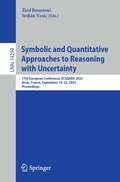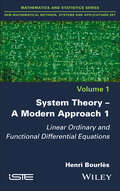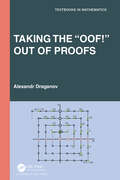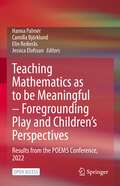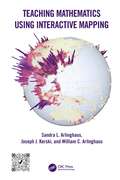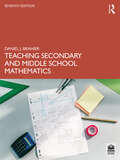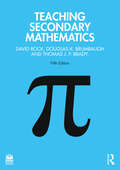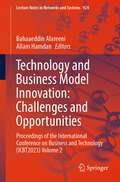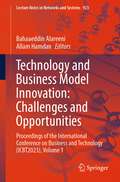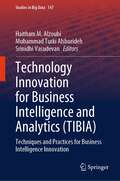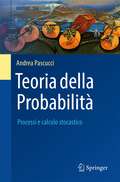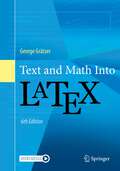- Table View
- List View
Sustained Simulation Performance 2022: Proceedings of the Joint Workshop on Sustained Simulation Performance, High-Performance Computing Center Stuttgart (HLRS), University of Stuttgart and Tohoku University, May and October 2022
by Michael M. Resch Wolfgang Bez Hiroaki Kobayashi Hiroyuki Takizawa Johannes GebertThis book presents the state of the art in High-Performance Computing on modern supercomputer architectures. It addresses trends in hardware and software development in general. The contributions cover a broad range of topics, from performance evaluations in context with power efficiency to Computational Fluid Dynamics and High-Performance Data Analytics. In addition, they explore new topics like the use of High-Performance Computers in the field of Artificial Intelligence and Machine Learning. All contributions are based on selected papers presented in 2022 at the 33rd Workshop on Sustained Simulation Performance, WSSP33, held at HLRS in Stuttgart, Germany, and WSSP34, held at Tohoku University in Sendai, Japan.
Symbolic and Quantitative Approaches to Reasoning with Uncertainty: 17th European Conference, ECSQARU 2023, Arras, France, September 19–22, 2023, Proceedings (Lecture Notes in Computer Science #14294)
by Zied Bouraoui Srdjan VesicThis book constitutes the refereed proceedings of the 17th European Conference on Symbolic and Quantitative Approaches to Reasoning with Uncertainty, ECSQARU 2023, held in Arras, France, in September 2023. The 35 full papers presented in this volume were carefully reviewed and selected from 46 submissions. The papers are organized in topical sections about Complexity and Database Theory; Formal Concept Analysis: Theoretical Advances; Formal Concept Analysis: Applications; Modelling and Explanation; Semantic Web and Graphs; Posters.
System Theory -- A Modern Approach, Volume 1: Linear Ordinary and Functional Differential Equations
by Henri BourlèsThe theory of dynamic systems is addressed in this book in accordance with the “modern” approach, heir to algebraic analysis, which has been implemented since the last decade of the 20th century. After a reminder of the evolution of the representation of systems based on transfer functions or matrices, the duality of controllability and observability is revisited, and new results are produced concerning time-varying discrete-time systems. To complete and improve the existing analyses, the poles and zeros of linear systems and their interconnections are presented in a new way, as well as the problem of systems governed by functional differential equations (of retarded or neutral type) and their stabilization. This book also proposes known and original mathematical complements.
System Theory -- A Modern Approach, Volume 1: Linear Ordinary and Functional Differential Equations
by Henri BourlèsThe theory of dynamic systems is addressed in this book in accordance with the "modern" approach, heir to algebraic analysis, which has been implemented since the last decade of the 20th century. After a reminder of the evolution of the representation of systems based on transfer functions or matrices, the duality of controllability and observability is revisited, and new results are produced concerning time-varying discrete-time systems. To complete and improve the existing analyses, the poles and zeros of linear systems and their interconnections are presented in a new way, as well as the problem of systems governed by functional differential equations (of retarded or neutral type) and their stabilization. This book also proposes known and original mathematical complements.
Taking the “Oof!” Out of Proofs (Textbooks in Mathematics)
by Alexandr DraganovThis book introduces readers to the art of doing mathematical proofs. Proofs are the glue that holds mathematics together. They make connections between math concepts and show why things work the way they do. This book teaches the art of proofs using familiar high-school concepts, such as numbers, polynomials, functions, and trigonometry. It retells math as a story, where the next chapter follows from the previous one.Readers will see how various mathematical concepts are tied and will see that mathematics is not a pile of formulas and facts; rather, it has an orderly and beautiful edifice.The author begins with basic rules of logic and then progresses through the topics already familiar to the students: numbers, inequalities, functions, polynomials, exponents, and trigonometric functions. There are also beautiful proofs for conic sections, sequences, and Fibonacci numbers. Each chapter has exercises for the reader.Reviewer Comments:I find the book very impressive. The choice and sequence of topics is excellent, and it is wonderful to have all of these things together in one volume. Theorems are clearly stated, and proofs are accurate. – Michael ComenetzThe thoroughness of the narrative is one of the main strengths of the book. The book provides a perfect illustration of mathematical thinking. Each step of a given derivation is precise and clear. – Julie GershunskayaDraganov’s book stands out from the many competing books. Draganov’s goal is to show that mathematics depends on the notion of proof. Unlike other transition books, he addresses mathematical topics at an accessible level, rather than topics studied later in the university curriculum. – Ken Rosen
Taking the “Oof!” Out of Proofs: A Primer On Mathematical Proofs (Textbooks in Mathematics)
by Alexandr DraganovThis book introduces readers to the art of doing mathematical proofs. Proofs are the glue that holds mathematics together. They make connections between math concepts and show why things work the way they do. This book teaches the art of proofs using familiar high-school concepts, such as numbers, polynomials, functions, and trigonometry. It retells math as a story, where the next chapter follows from the previous one.Readers will see how various mathematical concepts are tied and will see that mathematics is not a pile of formulas and facts; rather, it has an orderly and beautiful edifice.The author begins with basic rules of logic and then progresses through the topics already familiar to the students: numbers, inequalities, functions, polynomials, exponents, and trigonometric functions. There are also beautiful proofs for conic sections, sequences, and Fibonacci numbers. Each chapter has exercises for the reader.Reviewer Comments:I find the book very impressive. The choice and sequence of topics is excellent, and it is wonderful to have all of these things together in one volume. Theorems are clearly stated, and proofs are accurate. – Michael ComenetzThe thoroughness of the narrative is one of the main strengths of the book. The book provides a perfect illustration of mathematical thinking. Each step of a given derivation is precise and clear. – Julie GershunskayaDraganov’s book stands out from the many competing books. Draganov’s goal is to show that mathematics depends on the notion of proof. Unlike other transition books, he addresses mathematical topics at an accessible level, rather than topics studied later in the university curriculum. – Ken Rosen
Tax Avoidance Research: Exploring Networks and Dynamics of Global Academic Collaboration (SIDREA Series in Accounting and Business Administration)
by Antonio De Vito Francesco GrossettiThis book explores the intricate realm of tax avoidance, synthesizing existing empirical literature in the field. The work starts by exploring the theoretical underpinnings of tax avoidance, dissecting its unique features compared to tax evasion. It delves into measurement methodologies and dissects the determinants contributing to its prevalence. Moreover, it analyzes the economic consequences of tax avoidance, emphasizing its impact on critical accounting issues, including financial reporting transparency, cost of capital, and firm value. Next, the book offers a foundational understanding of graph theory, unveiling the core elements of networks, such as nodes and edges. The book covers the theoretical fundamentals and addresses the practical side of constructing networks based on real-world relational systems. It emphasizes the importance of effective data collection and representation methods and underscores the importance of optimizing network layouts for enhanced visual representation. Using network analysis, the book further offers a deep dive into empirical studies on tax avoidance over the past two decades, revealing insights into the collaborative nature of this stream of research. Finally, the book summarizes the key insights of the network analysis on tax avoidance. It underscores the dynamic nature of individual authors' roles and affiliations, shedding light on the collaborative dynamics within institutions.
Teaching Mathematics as to be Meaningful – Foregrounding Play and Children’s Perspectives: Results from the POEM5 Conference, 2022
by Hanna Palmér Camilla Björklund Elin Reikerås Jessica ElofssonThis open access book’s theme is Teaching mathematics as to be meaningful – foregrounding children’s play and perspectives. It discusses the relation between teachers, children and mathematical content within the context of play with a particular focus on the framing of these relations within this context, which is an important theme in the debate on whether teaching should be integrated with or separated from children’s play. The work further addresses meaningfulness in the learning process, particularly from the child’s perspective. Globally, most guidelines and curricula for early childhood education mention play as one of the key features for young children’s learning. Still, there are quite different views on the definitions of play and in what ways play should become part of children’s learning. The chapters of the book mirror the research topics presented at the fifth POEM conference in May 2022 divided into four sub-themes: Play and learning, Children’s perspectives on mathematics, Teachers’ competencies and Theorizing aspects of early mathematics education.
Teaching Mathematics Using Interactive Mapping
by Sandra L. Arlinghaus Joseph J. Kerski William C. ArlinghausTeaching Mathematics Using Interactive Mapping offers novel ways to learn basic math topics such as simple relational measures or measuring hierarchies through customized interactive mapping activities. These activities focus on interactive web-based Geographic Information System (GIS) and are relevant to today’s problems and challenges. Written in a guided, hands-on, understandable manner, all activities are designed to build practical and problem-solving skills that rest on mathematical principles and move students from thinking about maps as references that focus solely on "where is" something, to analytical tools, focusing primarily on the "whys of where." Success with this transition through interaction permits most readers to master mathematical concepts and GIS tools. FEATURES Offers custom-designed geographical activities to fit with specific mathematical topics Helps students become comfortable using mathematics in a variety of professions Provides an innovative, engaging, and practical set of activities to ease readers through typically difficult, often elementary, mathematical topics: fractions, the distributive law, and much more Uses web-based GIS maps, apps, and other tools and data that can be accessed on any device, anywhere, at any time, requiring no prior GIS background Written by experienced teachers and researchers with lifelong experience in teaching mathematics, geography, and spatial analysis This textbook applies to undergraduate and graduate students in universities and community colleges including those in basic mathematics courses, as well as upper-level undergraduate and graduate students taking courses in geographic information systems, remote sensing, photogrammetry, geography, geodesy, information science, engineering, and geology. Professionals interested in learning techniques and technologies for collecting, analyzing, managing, processing, and visualizing geospatial datasets will also benefit from this book as they refresh their knowledge in mathematics.
Teaching Mathematics Using Interactive Mapping
by Sandra L. Arlinghaus Joseph J. Kerski William C. ArlinghausTeaching Mathematics Using Interactive Mapping offers novel ways to learn basic math topics such as simple relational measures or measuring hierarchies through customized interactive mapping activities. These activities focus on interactive web-based Geographic Information System (GIS) and are relevant to today’s problems and challenges. Written in a guided, hands-on, understandable manner, all activities are designed to build practical and problem-solving skills that rest on mathematical principles and move students from thinking about maps as references that focus solely on "where is" something, to analytical tools, focusing primarily on the "whys of where." Success with this transition through interaction permits most readers to master mathematical concepts and GIS tools. FEATURES Offers custom-designed geographical activities to fit with specific mathematical topics Helps students become comfortable using mathematics in a variety of professions Provides an innovative, engaging, and practical set of activities to ease readers through typically difficult, often elementary, mathematical topics: fractions, the distributive law, and much more Uses web-based GIS maps, apps, and other tools and data that can be accessed on any device, anywhere, at any time, requiring no prior GIS background Written by experienced teachers and researchers with lifelong experience in teaching mathematics, geography, and spatial analysis This textbook applies to undergraduate and graduate students in universities and community colleges including those in basic mathematics courses, as well as upper-level undergraduate and graduate students taking courses in geographic information systems, remote sensing, photogrammetry, geography, geodesy, information science, engineering, and geology. Professionals interested in learning techniques and technologies for collecting, analyzing, managing, processing, and visualizing geospatial datasets will also benefit from this book as they refresh their knowledge in mathematics.
Teaching Secondary and Middle School Mathematics
by Daniel J. BrahierTeaching Secondary and Middle School Mathematics combines the latest developments in research, technology, and standards with a vibrant writing style to help teachers prepare for the excitement and challenges of teaching secondary and middle school mathematics. The book explores the mathematics teaching profession by examining the processes of planning, teaching, and assessing student progress through practical examples and recommendations. Beginning with an examination of what it means to teach and learn mathematics, the reader is led through the essential components of teaching, concluding with an examination of how teachers continue with professional development throughout their careers. Hundreds of citations are used to support the ideas presented in the text, and specific websites and other resources are presented for future study by the reader. Classroom scenarios are presented to engage the reader in thinking through specific challenges that are common in mathematics classrooms. The seventh edition has been updated and expanded with particular emphasis on the latest technology, standards, and other resources. The reader is introduced to the ways that students think and how to best meet their needs through planning that involves attention to differentiation, as well as how to manage a classroom for success. Features include: • Following on from the sixth edition, assessment takes a central role in planning and teaching. Unit 3 (of 5) addresses the use of summative and formative assessments to inform classroom teaching practices. • A new appendix is included that lists websites that can be used in a methods class to view other teachers interacting with students for discussion of effective teaching practices. • The feature entitled “Links and Resources” has been updated in each of the 13 chapters. Five strongly recommended and practical resources are spotlighted at the end of each chapter as an easy reference to some of the most important materials on the topic. • Approximately 150 new citations have either replaced or been added to the text to reflect the latest in research, materials, and resources that support the teaching of mathematics. • Significant revisions have been made to Chapter 12, which now includes updated research and practices as well as a discussion on culturally responsive pedagogy. Likewise, Chapter 8 now includes a description of best and high-leverage teaching practices, and a discussion in Chapter 11 on alternative high school mathematics electives for students has been added. • Chapter 9, on the practical use of classroom technology, has again been revised to reflect the latest tools available to classroom teachers, including apps that can be run on handheld personal devices, in light of changes in education resulting from the global pandemic. An updated Instructor’s Manual features a test bank, sample classroom activities, PowerPoint slide content, chapter summaries, and learning outcomes for each chapter, and can be accessed by instructors online at www.routledge.com/9781032472867.
Teaching Secondary and Middle School Mathematics
by Daniel J. BrahierTeaching Secondary and Middle School Mathematics combines the latest developments in research, technology, and standards with a vibrant writing style to help teachers prepare for the excitement and challenges of teaching secondary and middle school mathematics. The book explores the mathematics teaching profession by examining the processes of planning, teaching, and assessing student progress through practical examples and recommendations. Beginning with an examination of what it means to teach and learn mathematics, the reader is led through the essential components of teaching, concluding with an examination of how teachers continue with professional development throughout their careers. Hundreds of citations are used to support the ideas presented in the text, and specific websites and other resources are presented for future study by the reader. Classroom scenarios are presented to engage the reader in thinking through specific challenges that are common in mathematics classrooms. The seventh edition has been updated and expanded with particular emphasis on the latest technology, standards, and other resources. The reader is introduced to the ways that students think and how to best meet their needs through planning that involves attention to differentiation, as well as how to manage a classroom for success. Features include: • Following on from the sixth edition, assessment takes a central role in planning and teaching. Unit 3 (of 5) addresses the use of summative and formative assessments to inform classroom teaching practices. • A new appendix is included that lists websites that can be used in a methods class to view other teachers interacting with students for discussion of effective teaching practices. • The feature entitled “Links and Resources” has been updated in each of the 13 chapters. Five strongly recommended and practical resources are spotlighted at the end of each chapter as an easy reference to some of the most important materials on the topic. • Approximately 150 new citations have either replaced or been added to the text to reflect the latest in research, materials, and resources that support the teaching of mathematics. • Significant revisions have been made to Chapter 12, which now includes updated research and practices as well as a discussion on culturally responsive pedagogy. Likewise, Chapter 8 now includes a description of best and high-leverage teaching practices, and a discussion in Chapter 11 on alternative high school mathematics electives for students has been added. • Chapter 9, on the practical use of classroom technology, has again been revised to reflect the latest tools available to classroom teachers, including apps that can be run on handheld personal devices, in light of changes in education resulting from the global pandemic. An updated Instructor’s Manual features a test bank, sample classroom activities, PowerPoint slide content, chapter summaries, and learning outcomes for each chapter, and can be accessed by instructors online at www.routledge.com/9781032472867.
Teaching Secondary Mathematics
by David Rock Douglas K. Brumbaugh Thomas J. BradySolidly grounded in up-to-date research, theory, and technology, Teaching Secondary Mathematics is a practical, student-friendly, and popular text for secondary mathematics methods courses. It provides clear and useful approaches for mathematics teachers and shows how concepts typically found in a secondary mathematics curriculum can be taught in a positive and encouraging way. The thoroughly revised fifth edition combines this pragmatic approach with truly innovative and integrated technology content throughout. Synthesized content between the book and a comprehensive Instructor and Student Resource website offers expanded discussion of chapter topics, additional examples, and technological tips, such as using and assessing artificial intelligence.Each chapter features tried-and-tested pedagogical techniques, problem-solving challenges, discussion points, activities, mathematical challenges, and student-life-based applications that will encourage students to think and do.New to the fifth edition: A fully revised chapter on technological advancements in the teaching of mathematics, including the use of artificial intelligence A new chapter on equity, shame, and anxiety in the mathematics classroom Connections to both the updated National Council of Teachers of Mathematics (NCTM) Focal Points and Standards Problem-solving challenges and sticky questions featured in each chapter to encourage students to think through everyday issues and possible solutions A fresh interior design to better highlight pedagogical elements and key features A completely updated Instructor and Student Resource site with chapter-by-chapter video lessons, teacher tools, problem solving Q&As, exercises, and helpful links and resources.
Teaching Secondary Mathematics
by David Rock Douglas K. Brumbaugh Thomas J. BradySolidly grounded in up-to-date research, theory, and technology, Teaching Secondary Mathematics is a practical, student-friendly, and popular text for secondary mathematics methods courses. It provides clear and useful approaches for mathematics teachers and shows how concepts typically found in a secondary mathematics curriculum can be taught in a positive and encouraging way. The thoroughly revised fifth edition combines this pragmatic approach with truly innovative and integrated technology content throughout. Synthesized content between the book and a comprehensive Instructor and Student Resource website offers expanded discussion of chapter topics, additional examples, and technological tips, such as using and assessing artificial intelligence.Each chapter features tried-and-tested pedagogical techniques, problem-solving challenges, discussion points, activities, mathematical challenges, and student-life-based applications that will encourage students to think and do.New to the fifth edition: A fully revised chapter on technological advancements in the teaching of mathematics, including the use of artificial intelligence A new chapter on equity, shame, and anxiety in the mathematics classroom Connections to both the updated National Council of Teachers of Mathematics (NCTM) Focal Points and Standards Problem-solving challenges and sticky questions featured in each chapter to encourage students to think through everyday issues and possible solutions A fresh interior design to better highlight pedagogical elements and key features A completely updated Instructor and Student Resource site with chapter-by-chapter video lessons, teacher tools, problem solving Q&As, exercises, and helpful links and resources.
A Technical Guide to Mathematical Finance (Chapman and Hall/CRC Financial Mathematics Series)
by Derek ZweigA Technical Guide to Mathematical Finance covers those foundational mathematical topics most important to an aspiring or professional quant. The text goes beyond a simple recitation of methods and aims to impart a genuine understanding of the fundamental concepts underpinning most of the techniques and tools routinely used by those working in quantitative finance.Features Suitable for professional quants and graduate students in finance, and mathematical/quantitative finance “Concept Refreshers” used throughout to provide pithy summaries of complex topics Step-by-step detail for formal proofs and mathematical descriptions
A Technical Guide to Mathematical Finance (Chapman and Hall/CRC Financial Mathematics Series)
by Derek ZweigA Technical Guide to Mathematical Finance covers those foundational mathematical topics most important to an aspiring or professional quant. The text goes beyond a simple recitation of methods and aims to impart a genuine understanding of the fundamental concepts underpinning most of the techniques and tools routinely used by those working in quantitative finance.Features Suitable for professional quants and graduate students in finance, and mathematical/quantitative finance “Concept Refreshers” used throughout to provide pithy summaries of complex topics Step-by-step detail for formal proofs and mathematical descriptions
Technische Mechanik 2: Elastostatik
by Dietmar Gross Jörg Schröder Werner Hauger Wolfgang A. WallDer Band Elastostatik ist der zweite Teil des vierbändigen Lehrbuchs; er erscheint nun in der 15. Auflage. Ziel des didaktisch ausgefeilten Werkes ist es, das Verständnis der wesentlichen Grundgesetze der Mechanik zu vermitteln und die Fähigkeit zu entwickeln, mit Hilfe der Mechanik Ingenieurprobleme zu formulieren und selbständig zu lösen. Es wurde ein möglichst einfacher Zugang zur Mechanik gewählt. Der dargestellte Stoff orientiert sich am Umfang der Mechanikkurse an deutschsprachigen Hochschulen und ist für alle Bachelor-, Master- und Diplomstudiengänge hervorragend geeignet. Das Buch enthält zahlreiche durchgerechnete Beispiele. Die neue Auflage erhält zusätzlich zahlreiche Flashcards, die das Verständnis fördern und das Lernen erleichtern. Band 1 behandelt die Statik, Band 3 die Kinetik und Band 4 die Hydromechanik, Elemente der Höheren Mechanik und die Numerischen Methoden; geeignet für Ingenieurstudenten aller Fachrichtungen an Universitäten und Hochschulen. Auf Grund des großen Erfolges ist die Lehrbuchreihe mittlerweile auch in englischer Sprache als dreibändiges Werk "Engineering Mechanics" erschienen. Zusätzliche Fragen per App: Laden Sie die Springer-Nature-Flashcards-App kostenlos herunter und nutzen Sie exklusives Zusatzmaterial, um Ihr Wissen zu prüfen. Die freundliche Aufnahme, welche dieses Buch gefunden hat, macht eine Neuauflage erforderlich. Sie wurde genutzt, um eine Reihe von Verbesserungen und Ergänzungen vorzunehmen. Außerdem wurden Text und Abbildungen dem neuen Springer Layout angepasst, welches erlaubt, eine attraktive E-Book Variante bereitzustellen. Die Zielgruppen Das Buch wendet sich an Studierende der Ingenieurwissenschaften aller Fachrichtungen an Universitäten und Hochschulen.
Technology and Business Model Innovation: Proceedings of the International Conference on Business and Technology (ICBT2023) Volume 2 (Lecture Notes in Networks and Systems #924)
by Bahaaeddin Alareeni Allam HamdanThis book proceedings addresses a crucial gap in understanding the impact of technology on Business Model Innovation (BMI). It emphasizes the need for further research to explore the intricate relationship between technology and BMI, focusing on opportunities and challenges. By delving into how technology influences emerging business model innovations and enhances operational efficiency, the publication aims to advance knowledge. Inviting diverse research methods, it sheds light on various ideas within the technology and BMI realm. Tailored for students, scholars, professionals, and policymakers, this book contributes to the evolving field of BMI and technology.
Technology and Business Model Innovation: Proceedings of the International Conference on Business and Technology (ICBT2023), Volume 1 (Lecture Notes in Networks and Systems #923)
by Bahaaeddin Alareeni Allam HamdanThis book proceedings addresses a crucial gap in understanding the impact of technology on Business Model Innovation (BMI). It emphasizes the need for further research to explore the intricate relationship between technology and BMI, focusing on opportunities and challenges. By delving into how technology influences emerging business model innovations and enhances operational efficiency, the publication aims to advance knowledge. Inviting diverse research methods, it sheds light on various ideas within the technology and BMI realm. Tailored for students, scholars, professionals, and policymakers, this book contributes to the evolving field of BMI and technology.
Technology Innovation for Business Intelligence and Analytics: Techniques and Practices for Business Intelligence Innovation (Studies in Big Data #147)
by Haitham M. Alzoubi Muhammad Turki Alshurideh Srinidhi VasudevanThis book provides a standpoint on how to effectively use technology innovation for business intelligence and analytics. It presents an approach that combines cutting-edge technological advancements with practical applications in the business world. The book covers a range of innovative technologies and how they can be applied to enhance business intelligence and analytics. It is primarily aimed at professionals in the business field data analysts and students studying subjects. This book is especially beneficial for those who want to grasp and apply the technological trends in making strategic business decisions. Its comprehensive coverage makes it an indispensable resource for anyone, in the intersection of technology and business analytics.
Teoria della Probabilità: Processi e calcolo stocastico (UNITEXT #156)
by Andrea PascucciQuesto libro offre un approccio moderno alla teoria dei processi stocastici in tempo continuo e del calcolo differenziale stocastico. I contenuti vengono trattati in modo rigoroso, completo e autonomo. Nella prima parte, viene introdotta la teoria dei processi di Markov e delle martingale, con un approfondimento sul moto Browniano e il processo di Poisson. Di seguito, è sviluppata la teoria dell'integrazione stocastica per semi-martingale continue. Una parte sostanziosa è dedicata alle equazioni differenziali stocastiche, ai principali risultati di risolubilità e unicità in senso debole e forte, alle equazioni stocastiche lineari e alla relazione con le equazioni differenziali alle derivate parziali deterministiche. Ogni capitolo è corredato di numerosi esempi. Questo testo nasce dall'esperienza più che ventennale di insegnamento in corsi su processi e calcolo stocastico presso le lauree magistrali in Matematica, in Quantitative finance e i corsi post-laurea in Matematica per le applicazioni e in Finanza matematica dell'Università di Bologna. Il libro raccoglie materiale per almeno due insegnamenti semestrali in corsi di studio scientifici (Matematica, Fisica, Ingegneria, Statistica, Economia...) e intende fornire un solido background a coloro che sono interessati allo sviluppo della teoria e delle applicazioni del calcolo stocastico. Questo testo completa il percorso iniziato col primo volume di Teoria della Probabilità - Variabili aleatorie e distribuzioni, attraverso una selezione di temi classici avanzati di analisi stocastica.
Territorial Inequalitie
by Magali Talandier Josselin TallecSpatial planning has embraced the idea of dealing with territorial inequalities by focusing on equipment logic on a national scale, and then economic development on a local scale. Today, this issue is creating new angles of debate with strong political resonances (e.g. Brexit, French gilets jaunes movement). Interpretations of these movements are often quick and binary, such as: the contrast between metropolises and peripheries, between cities and the countryside, between the north and the south or between the east and the west of the European Union. Territorial Inequalities sheds light on the social, political and operational implications of these divergences. The chapters cover the subject at different scales of action and observation (from the neighborhood to the world), but also according to their interdependences. To deal with such a vast and ambitious theme, the preferred approach is that of territorial development in terms of public policy, namely spatial planning.
Territorial Inequalities
by Magali Talandier Josselin TallecSpatial planning has embraced the idea of dealing with territorial inequalities by focusing on equipment logic on a national scale, and then economic development on a local scale. Today, this issue is creating new angles of debate with strong political resonances (e.g. Brexit, French gilets jaunes movement). Interpretations of these movements are often quick and binary, such as: the contrast between metropolises and peripheries, between cities and the countryside, between the north and the south or between the east and the west of the European Union. Territorial Inequalities sheds light on the social, political and operational implications of these divergences. The chapters cover the subject at different scales of action and observation (from the neighborhood to the world), but also according to their interdependences. To deal with such a vast and ambitious theme, the preferred approach is that of territorial development in terms of public policy, namely spatial planning.
Text and Math Into LaTeX
by George GratzerFor more than 30 years, this comprehensive manual has been the standard introduction and complete reference for writing articles and books containing mathematical formulas. This sixth edition uses a slightly changed title, Text and Math into LaTeX, to emphasize the importance of text in mathematical/scientific composition. Sections that contained commands no longer much needed (such as \includeonly) and the introductory sections to PDF (now ubiquitous) have been omitted. Many sections are now enhanced with discussion of new and useful packages. An occasional encouragement for the reader to consult ChatGPT for confirmation on various points illustrates the positive relationship between ChatGPT and LaTeX.The new Chapter 17 describes recent developments that enhance, or replace, BibTeX and the new Appendix C, introduces the reader to ChatGPT.Key features: An example-based, visual approach and agentle introduction with the Short CourseA detailed exposition of multiline math formulas with a Visual GuideA unified approach to TeX, LaTeX, and the AMS enhancementsA quick introduction to creating presentations with formulasA detailed approach to creating illustrationsExtras are provided on SpringerLink for the following chapters: 1, 2, 3, 4, 6, 7, 10, 11, 13, 14, 15, 16, 17, 18 and Appendices A, BExtras for Appendices A & B can be found in Extras for Chapter 18.
Theoretical and Computational Fluid Mechanics: Existence, Blow-up, and Discrete Exterior Calculus Algorithms (Chapman & Hall/CRC Numerical Analysis and Scientific Computing Series)
by Terry E. Moschandreou Keith Afas Khoa NguyenTheoretical and Computational Fluid Mechanics: Existence, Blow-up, and Discrete Exterior Calculus Algorithms centralizes the main and current topics in theoretical and applied fluid dynamics at the intersection of a mathematical and non-mathematical environment. The book is accessible to anyone with a basic level of understanding of fluid dynamics and yet still engaging for those of a deeper understanding.The book is aimed at theorists and applied mathematicians from a wide range of scientific fields, including the social, health, and physical sciences. It provides a step-by-step guide to the construction of solutions of both elementary and open problems of viscous and non-viscous models, and for the applications of such models for the functional analysis and real analysis of data. Features Offers a self-contained treatment that does not require a previous background in fluid dynamics. Suitable as a reference text for graduate students, researchers, and professionals, and could easily be used as a teaching resource. Provides various examples using Maple, Mathematica, and to a lesser extent Matlab programming languages.

